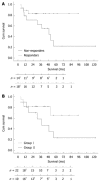Evaluation of Cladribine treatment in refractory celiac disease type II
- PMID: 21274381
- PMCID: PMC3027018
- DOI: 10.3748/wjg.v17.i4.506
Evaluation of Cladribine treatment in refractory celiac disease type II
Abstract
Aim: To evaluate cladribine [2-chlorodeoxyadenosine (2-CdA)] therapy in refractory celiac disease (RCD) II.
Methods: An open-label cohort-study of RCD II patients treated with 2-CdA was performed between 2000 and 2010. Survival rate, enteropathy associated T-cell lymphoma (EATL) occurrence, clinical course, and histological and immunological response rates were evaluated.
Results: Overall, 32 patients were included with a median follow-up of 31 mo. Eighteen patients responded well to 2-CdA. Patients responsive to 2-CdA had a statistically significant increased survival compared to those who were unresponsive. The overall 3- and 5-year survival was 83% in the responder and 63% and 22% in the non-responder group, respectively. The overall 2-year clinical, histological and immunological response rates were 81%, 47% and 41%, respectively. Progression into EATL was reported in 16%, all of these patients died.
Conclusion: Treatment of RCD II with 2-CdA holds promise, showing excellent clinical and histological response rates, and probably less frequent transition into EATL.
Keywords: Cladribine; Clinical course; Enteropathy associated T-cell lymphoma; Refractory celiac disease; Survival.
Figures



Similar articles
-
Cladribine therapy in refractory celiac disease with aberrant T cells.Clin Gastroenterol Hepatol. 2006 Nov;4(11):1322-7; quiz 1300. doi: 10.1016/j.cgh.2006.07.007. Epub 2006 Sep 18. Clin Gastroenterol Hepatol. 2006. PMID: 16979946 Clinical Trial.
-
Auto-SCT in refractory celiac disease type II patients unresponsive to cladribine therapy.Bone Marrow Transplant. 2011 Jun;46(6):840-6. doi: 10.1038/bmt.2010.199. Epub 2010 Sep 6. Bone Marrow Transplant. 2011. PMID: 20818442 Clinical Trial.
-
Monitoring nonresponsive patients who have celiac disease.Gastrointest Endosc Clin N Am. 2006 Apr;16(2):317-27. doi: 10.1016/j.giec.2006.03.005. Gastrointest Endosc Clin N Am. 2006. PMID: 16644460 Review.
-
Clinical staging and survival in refractory celiac disease: a single center experience.Gastroenterology. 2009 Jan;136(1):99-107; quiz 352-3. doi: 10.1053/j.gastro.2008.10.013. Epub 2008 Oct 8. Gastroenterology. 2009. PMID: 18996383 Free PMC article.
-
Epidemiologic and therapeutic aspects of refractory coeliac disease - a systematic review.Dan Med J. 2016 Dec;63(12):A5307. Dan Med J. 2016. PMID: 27910801 Review.
Cited by
-
Refractory Celiac Disease: What the Gastroenterologist Should Know.Int J Mol Sci. 2024 Sep 26;25(19):10383. doi: 10.3390/ijms251910383. Int J Mol Sci. 2024. PMID: 39408713 Free PMC article. Review.
-
Phenotype and Treatment Options for Mesenteric Lymph Node Cavitating Syndrome in Coeliac Disease: A Case Series and Literature Review.J Clin Med. 2024 Sep 12;13(18):5417. doi: 10.3390/jcm13185417. J Clin Med. 2024. PMID: 39336903 Free PMC article.
-
Old and New Adjunctive Therapies in Celiac Disease and Refractory Celiac Disease: A Review.Int J Mol Sci. 2023 Aug 15;24(16):12800. doi: 10.3390/ijms241612800. Int J Mol Sci. 2023. PMID: 37628981 Free PMC article. Review.
-
The Risk of Malignancies in Celiac Disease-A Literature Review.Cancers (Basel). 2021 Oct 21;13(21):5288. doi: 10.3390/cancers13215288. Cancers (Basel). 2021. PMID: 34771450 Free PMC article. Review.
-
Small bowel capsule endoscopy in refractory celiac disease: a luxury or a necessity?Ann Gastroenterol. 2021;34(2):188-195. doi: 10.20524/aog.2021.0586. Epub 2021 Jan 27. Ann Gastroenterol. 2021. PMID: 33654358 Free PMC article.
References
-
- Sollid LM. Molecular basis of celiac disease. Annu Rev Immunol. 2000;18:53–81. - PubMed
-
- Green PH, Jabri B. Coeliac disease. Lancet. 2003;362:383–391. - PubMed
-
- Daum S, Cellier C, Mulder CJ. Refractory coeliac disease. Best Pract Res Clin Gastroenterol. 2005;19:413–424. - PubMed
-
- Cellier C, Delabesse E, Helmer C, Patey N, Matuchansky C, Jabri B, Macintyre E, Cerf-Bensussan N, Brousse N. Refractory sprue, coeliac disease, and enteropathy-associated T-cell lymphoma. French Coeliac Disease Study Group. Lancet. 2000;356:203–208. - PubMed
-
- Verbeek WH, Goerres MS, von Blomberg BM, Oudejans JJ, Scholten PE, Hadithi M, Al-Toma A, Schreurs MW, Mulder CJ. Flow cytometric determination of aberrant intra-epithelial lymphocytes predicts T-cell lymphoma development more accurately than T-cell clonality analysis in Refractory Celiac Disease. Clin Immunol. 2008;126:48–56. - PubMed
Publication types
MeSH terms
Substances
LinkOut - more resources
Full Text Sources
Other Literature Sources
Medical


